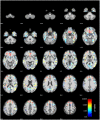Low bone mineral density is associated with gray matter volume decrease in UK Biobank
- PMID: 38020770
- PMCID: PMC10654785
- DOI: 10.3389/fnagi.2023.1287304
Low bone mineral density is associated with gray matter volume decrease in UK Biobank
Abstract
Objectives: Previous research has found an association of low bone mineral density (BMD) and regional gray matter (GM) volume loss in Alzheimer's disease (AD). We were interested whether BMD is associated with GM volume decrease in brains of a healthy elderly population from the UK Biobank.
Materials and methods: T1-weighted images from 5,518 women (MAge = 70.20, SD = 3.54; age range: 65-82 years) and 7,595 men (MAge = 70.84, SD = 3.68; age range: 65-82 years) without neurological or psychiatric impairments were included in voxel-based morphometry (VBM) analysis in CAT12 with threshold-free-cluster-enhancement (TFCE) across the whole brain.
Results: We found a significant decrease of GM volume in women in the superior frontal gyri, middle temporal gyri, fusiform gyri, temporal poles, cingulate gyri, precunei, right parahippocampal gyrus and right hippocampus, right ventral diencephalon, and right pre- and postcentral gyrus. Only small effects were found in men in subcallosal area, left basal forebrain and entorhinal area.
Conclusion: BMD is associated with low GM volume in women but less in men in regions afflicted in the early-stages of AD even in a sample without neurodegenerative diseases.
Keywords: Alzheimer’s disease; UK Biobank; VBM; bone mineral density; osteoporosis.
Copyright © 2023 Kalc, Dahnke, Hoffstaedter and Gaser.
Conflict of interest statement
The authors declare that the research was conducted in the absence of any commercial or financial relationships that could be construed as a potential conflict of interest. The author(s) declared that they were an editorial board member of Frontiers, at the time of submission. This had no impact on the peer review process and the final decision
Figures


References
LinkOut - more resources
Full Text Sources

